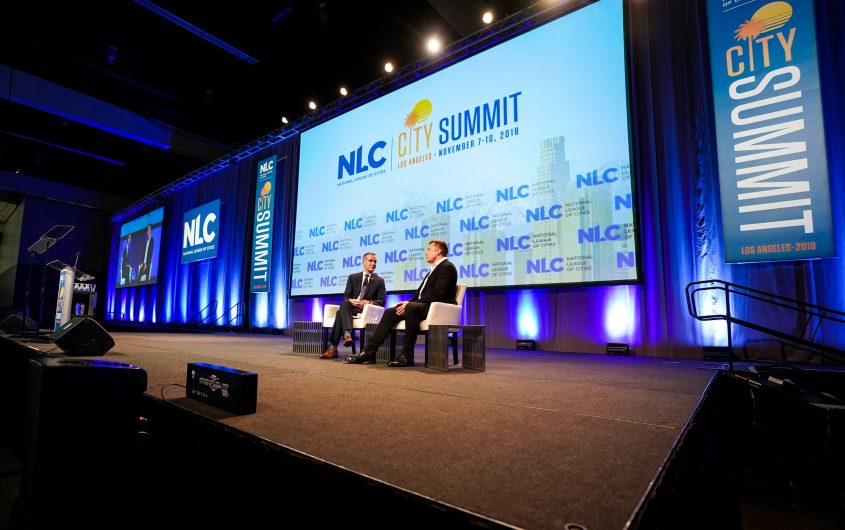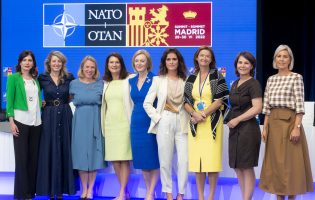
Eric Garcetti via Flickr
Advocating for the Local Level

Till Jürgens
Technical University of Darmstadt
Till Jürgens is a research associate at the Institute of Political Science at the Technical University of Darmstadt. He works on a research project about Local Government Associations (LGAs) in Germany and the United States, funded by the German Research Foundation (DFG). The research project aims to investigate how LGAs in different types of federal systems deal with collective action problems and how efficiently they lobby for local interests toward the federal government and parliament.
In his PhD project, Mr. Jürgens focuses on the internal organization and procedures of LGAs. More specifically, he examines how LGAs are able to develop collective agency. Collective agency is defined as the ability to form and implement own preferences. For gaining collective agency, LGAs need sufficient resources and the autonomy from their members to form a coherent position. Thereby, LGAs face the challenge of diverging interests among their members that may result from characteristics such as size, economic situation, or regional identity. In his research, Mr. Jürgens will examine whether and how LGAs can solve this problem and agree on a common position.
During his time at AICGS, Mr. Jürgens will study the organization of LGAs in the United States by conducting interviews with officials from the National League of Cities (NLC), the United States Conference of Mayors (USCM), the National Association of Counties (NACo), local government officials, and further relevant stakeholders of the field. The important questions for the interviews are: (1) How important are LGAs for representing the interests of local governments, especially in relation to individual lobbying? (2) How extensively are they equipped with resources for fulfilling their tasks? (3) How do they involve their members in internal decision-making procedures?
Local Government Associations in Germany and the United States
In recent years, politics in Germany and the United States were affected by enormous global challenges and crises, such as the COVID-19 pandemic, Russia’s invasion of Ukraine, growing inflation, increasing refugee movements, and climate change. Federal governments in Germany and the United States have introduced various programs and measures for dealing with these challenges. In both countries, local governments are responsible for the implementation of several of these programs. Therefore, they need to voice their interests and concerns to legislators in Berlin and Washington, especially to secure sufficient municipal funding for effective implementation of federal policies.
Local Government Associations: Voice of Municipalities
For effective representation of their interests, local governments in Germany and the United States have established associations called Local Government Associations (LGAs). In each country, there are three nationwide LGAs with direct or indirect membership opportunities for local governments.
In Germany:
- Deutscher Städtetag (DST, Association of German Cities); represents big and mid-sized cities; direct membership in national and Länder associations
- Deutscher Städte- und Gemeindebund (DStGB, Union of German Cities and Municipalities); represents small- and mid-sized cities and municipalities; umbrella organization of Länder associations; cities and municipalities are members in Länder associations
- Deutscher Landkreistag (DLT, Association of German Counties); represents all German counties; umbrella organization of Länder associations; counties are members in Länder associations
In the United States:
- National League of Cities (NLC); represents cities, towns, and villages; direct membership in national and state associations
- United States Conference of Mayors (USCM); represents cities with at least 30,000 inhabitants; direct membership in the national association
- National Association of Counties (NACo); represents counties; direct membership in national and state associations
LGAs in Germany and the United States fulfill similar tasks. These tasks can be summarized in the following four categories:
- Advocacy (to federal policymakers)
- Membership services (information, consulting, support)
- Networking (conferences, meetings, platforms)
- Education (seminars, events)
Despite institutional differences in politics between Germany and the United States, LGAs in the two countries also share several organizational characteristics and must deal with similar types of challenges. Although membership in these associations is voluntary, all associations represent a large share of local governments or even all municipalities in their respective local entities. Additionally, they all underline that they are another kind of interest group—compared to private interest groups—representing the interests of the public.
This article briefly presents the first empirical findings about the advocacy strategies and organization of LGAs in Germany and the United States.[1]
Different Strategies of Advocacy
In both countries, the national associations only act at the federal level. For the representation of local interests in the states and Länder, all LGAs (with exception of the U.S. Conference of Mayors) have state associations, which act as autonomous organizations and advocate independently to state governments and parliaments.
Different strategies and access points for advocating at the federal level. LGAs in Germany have specific participation rights in the bylaws of federal ministries and the Bundestag, where it is guaranteed that LGAs must be considered in all legislation affecting municipalities. Consequently, LGAs in Germany focus their advocacy activities on these participation rights to federal ministries and hearings of Bundestag committees. During the crises of the last years, this procedure showed positive and negative aspects. Formally, LGAs are guaranteed the right to voice their interests with the federal government during a time with short legislation processes and fast-changing policies. However, despite the formal participation rights, the federal government regularly did not include LGAs in its decision-making. In the United States, on the other hand, there are no comparable participation rights for LGAs. Therefore, LGAs established other channels for representing local interests by directly contacting members of the House of Representatives and senators, or bringing mayors to Washington, DC, to strengthen the legitimacy of their demands. The missing participation rights have the effect that U.S. LGAs are in a stronger position to compete with other interest groups for the attention of federal policymakers than their German counterparts.
Organizational Structure and Services
All LGAs consider advocacy with the federal government and parliaments as their most important task. Further, they all host annual conferences and other meetings for strengthening local networks. These meetings fulfill three purposes: First, local officials decide the policy positions of their LGA. Second, they link local officials with each other to learn and exchange experiences from their municipalities. And third, they connect local officials with higher-level officials. For example, at the last annual conferences of the NLC, NACo, and Deutscher Städte- und Gemeindebund, the heads of government (Joe Biden in the United States and Olaf Scholz in Germany), federal ministers, and leading party and parliament representatives attended as speakers.
Besides these similar functions, there are also differences in the ways American and German LGAs are organized, as well as the services they provide to their members. It seems that the number of services correlates with the organizational structure of the specific LGA. Three kinds of structures can be distinguished:
- Direct membership in the national organization and state associations (NLC, NACo, Deutscher Städtetag)
- Direct membership in the national association, but no state associations (U.S. Conference of Mayors)
- Only membership in state associations which consolidate into an umbrella organization (Deutscher Landkreistag, Deutscher Städte- und Gemeindebund)
The LGAs in the first group provide the largest number of services. They combine a membership model, where municipalities can directly join their national association, or are indirectly represented by their membership in a state association. Consequently, these LGAs can raise the highest amount of membership dues, and therefore have the most resources, such as financial or personal capabilities. In particular, the NLC and NACo are large organizations with several services and programs, representing over two thousand direct members and having strong cooperation with the private sector. Compared to these two LGAs, the Deutscher Städtetag has a much smaller budget. However, it is still able to maintain a headquarter of comparable size because of its personal and organizational unification with its biggest state association, the Union of Cities of Germany’s biggest Land North Rhine-Westphalia.
The LGAs of the second and third groups do not provide a comparable set of services. Historically, the U.S. Conference of Mayors concentrates on advocacy and exchange of experiences. The Deutscher Landkreistag and Deutscher Städte- und Gemeindebund are organized as umbrella organizations. Both organizations receive only a small portion of membership dues from their state associations and have smaller national headquarters. Consequently, the provision of membership services, such as individual consulting of local governments, reside with their state associations.
Summary
In Germany and the United States, LGAs are important players during current crises for securing effective legislation and implementation of federal policies. LGAs in both countries fulfill many important tasks, such as the representation of local interests in their nations’ capitals, the organization of meetings for municipal officials around their countries, or the provision of other services for local governments.
However, it is possible to identify differences regarding how LGAs are organized and how they represent the interests of local governments in federal politics. Comparing the different advocacy strategies could help to identify how LGAs in Germany and the United States can learn from each other. The participation rights for LGAs in Germany mark one central difference. German LGAs strongly focus their advocacy activities on these participation rights and benefit from easier access to federal policymakers than their U.S. counterparts. However, during the past years, German LGAs sometimes struggled to represent local interests when the federal government (illegitimately) did not consider them. In these cases, U.S. LGAs are more flexible in their strategies to influence federal policies because they do not have comparable participation rights and automatically need to work out other access opportunities.
Another important difference is that the LGAs in the United States have much bigger headquarters than LGAs in Germany (with the exception of the Deutscher Städtetag). In particular, the NLC and NACo are large organizations with a big number of direct members. Consequently, they have extensive resources for the provision of many services for their state leagues and members. For the German LGAs, change towards direct membership models could be an opportunity for increasing the size of these associations and improving their opportunities for supporting local governments.
[1] All information came from expert interviews with LGAs’ representatives and local officials.








